Before I get to the recipe, let me play proud papa for a few minutes, and share with you an episode with Luke this weekend that illustrates his spirit and character. I mentioned last week that he had started walking. However, as recently as his birthday, last Thursday, we thought it was impressive if he strung together 20 steps at a time. This weekend, coming out of church Saturday evening, he demanded to be allowed out of my arms to walk. He proceeded to walk almost the entirety of the 3/4 miles home. Here is a short section of his journey; he was already 10 minutes in and starting to get tired:
You can see him refusing any support from me – he wanted to do it all himself – and grinning at his new skill.
It was inevitable that he would take a tumble at some point, and soon after we stopped recording he did. He tripped and landed on all fours, just as in the video; but then he tried to launch himself back to his feet by sheer strength of arms, and didn’t quite make it all the way up. His head came back down first and he got a cut and bump on his forehead. I picked him up and he cried for 10 seconds or so; after 20 seconds he was smiling again:
Just seconds after this photo was taken, he demanded to be let back down to the ground, and proceeded to walk the rest of the way home, grinning. When we reached home, he complained at being taken indoors. Nevertheless, he was tired. Forty minutes later, he was asleep, and slept 11 hours.
OK, back to food. When Luke was age 6 months or so, we introduced him to solid food through this recipe. It is essentially a PHD meal suitable for infants, puréed with a blender. As is suitable for a baby, the “baby meal” has less protein and more carbs and fat than would an adult meal.
At first we mixed the purée into his milk. Luke soon came to love this “PHD milk” and started to refuse plain milk. Here he is enjoying his favorite meal:
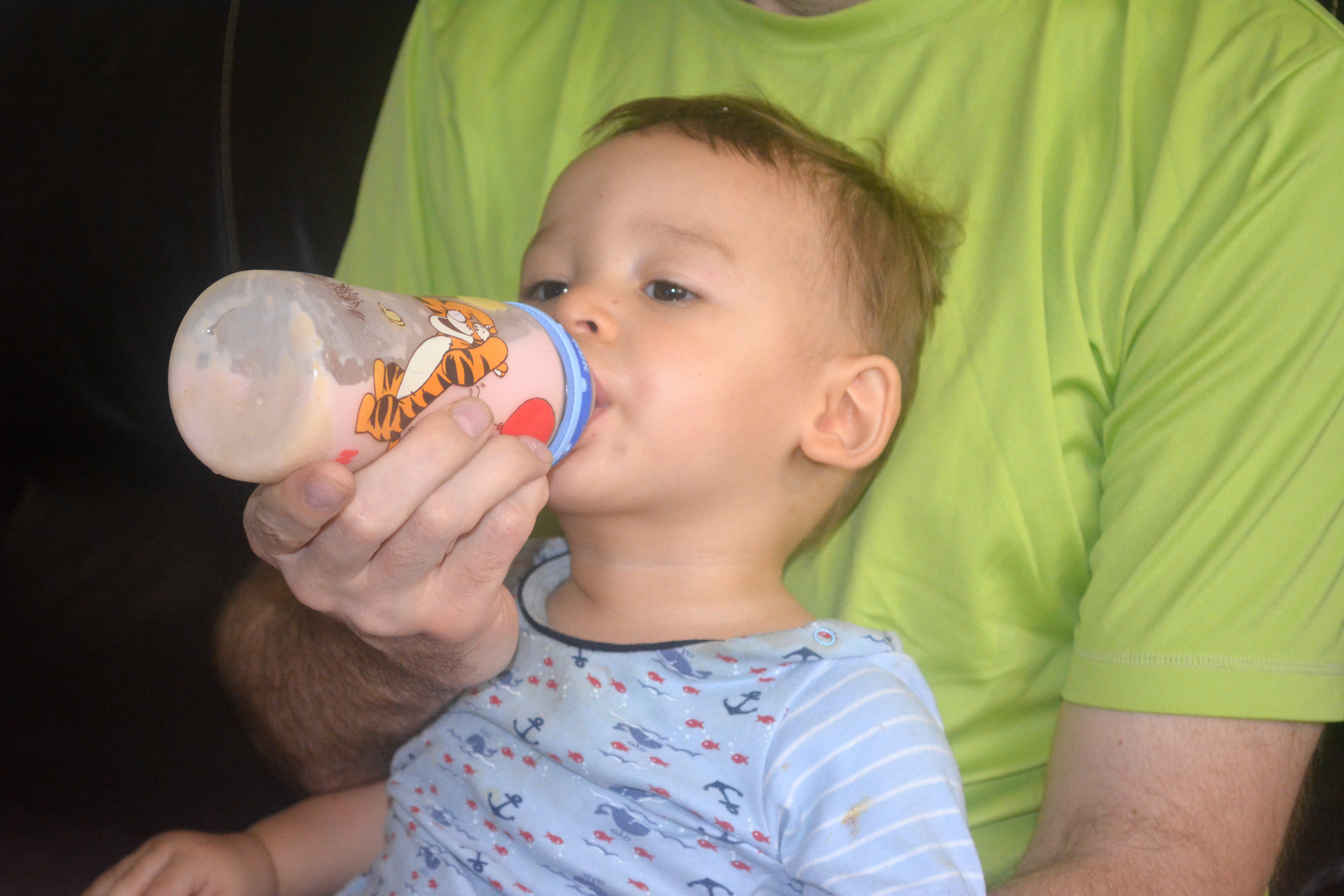 He also loves the baby food by itself. When we make it, we give him the mixing bowl and spoon, and he finishes everything eagerly (making a mess along the way).
He also loves the baby food by itself. When we make it, we give him the mixing bowl and spoon, and he finishes everything eagerly (making a mess along the way).
One note on ingredients. We recommend here that the meat be a mix of beef liver, oysters, salmon, and scallops.However, there’s no need to obtain all of these ingredients for every batch. It is fine to make a batch with one, then the next with another, then the next week with a third. Just balance the proportions over time. Instead of 5 g of each every week, get 20 g of each in over 4 weeks, in whatever fashion is most convenient for you.
A note on allergy risk: There have been some concerns that early introduction of shellfish could pose a heightened risk of allergy. The issue is discussed here. However, evidence has been piling in pointing the other way — that earlier introduction of potentially allergenic foods reduces the risk of allergy. More evidence. Since 2008, earlier introduction of allergenic solid foods has been the recommendation of the American Academy of Pediatrics. Current recommendations can be found here.
Nutritionally, this mix is not perfect, but it’s impossible to make a perfect baby food using natural whole foods. For example, breast milk has a higher zinc content than any natural whole food. Therefore, mixing in a few supplements, such as zinc and vitamin K and pantothenic acid, is a reasonable tactic.
[Further note: If you’re viewing this on the main page, click here to see the recipe.]
| Prep Time | 30 minutes |
| Cook Time | 30 minutes |
| Passive Time | 0 minutes |
| Servings |
bottles
|
- 100 g beets
- 100 g carrots
- 100 g potatoes or sweet potatoes
- 100 g cooked white rice
- 2 cups water
- 6 egg yolks
- 5 g beef liver
- 5 g oysters
- 5 g salmon
- 5 g scallops
- 1 tbsp apple cider vinegar or rice vinegar
- 1 tsp fish sauce
- 4 tbsp coconut milk
Ingredients
|
|
- Assemble the ingredients. In this batch we used 20 g beef liver for convenience; the next 3 weeks would have no liver and contain in total 20 g each of oysters, salmon, and scallops.
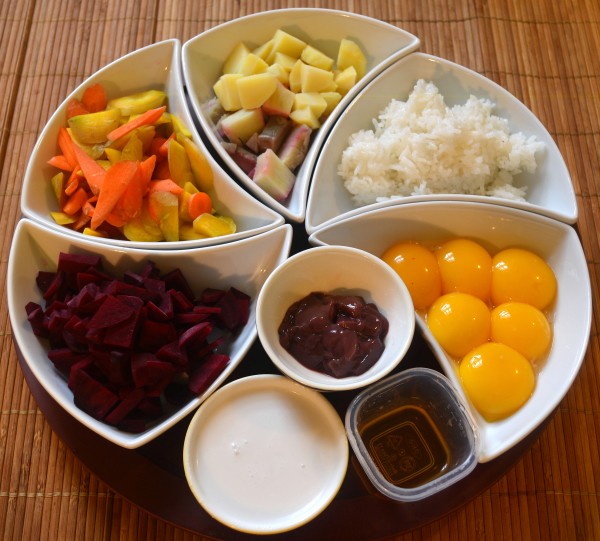
- In a saucepan, combine the beets, carrots, potatoes, white rice, 1.5 cups of water, beef liver, vinegar, fish sauce, and coconut milk. Cover (to prevent loss of moisture) and bring to a simmer for 30 minutes. Keep the heat as low as possible while still maintaining a simmer.
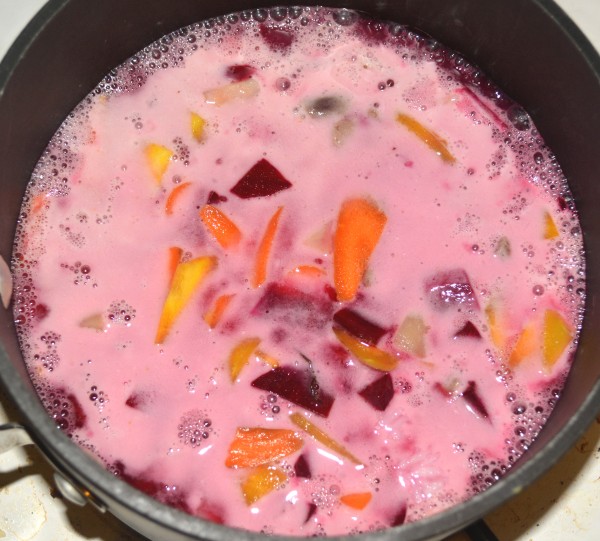
- While the other ingredients are simmering, mix the egg yolks with the other 1/2 cup water and set aside.
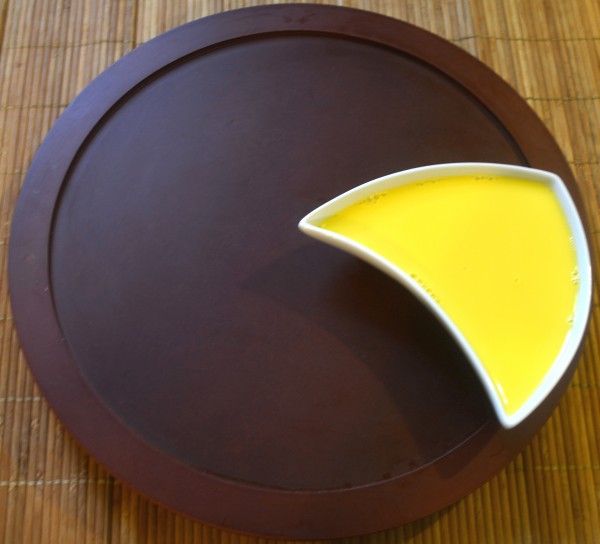
- While simmering, use an immersion blender to puree the ingredients in the saucepan. Once pureed, cover the pan again to prevent loss of water.
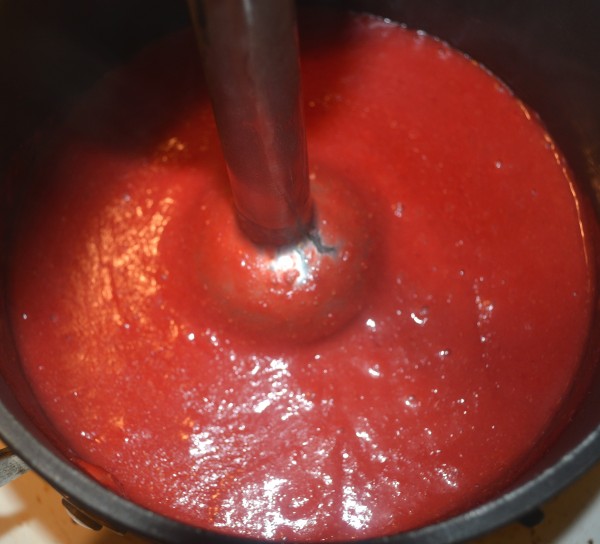
- After turning off the heat, strain the yolk-water mixture into the pan, stirring to mix the yolks throughout. The goal of the strainer is to let the yolk lipids pass through but keep the protein-rich yolk sacs in the strainer. Once the yolks are in, the residual heat will gently cook them, making any residual protein more easily digestible. Once the yolks are mixed in, we are done.
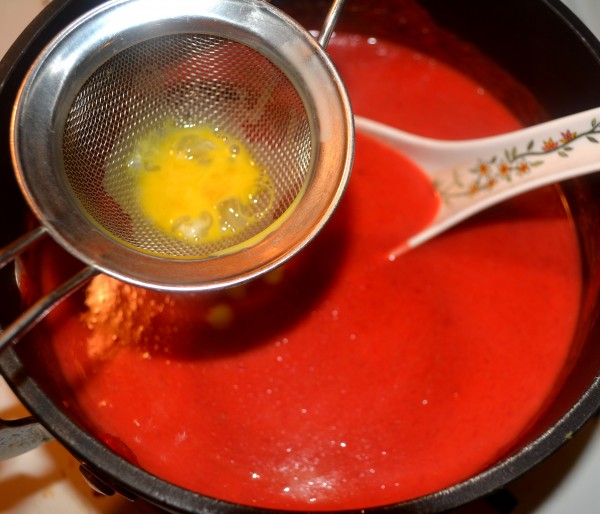
- We divide the resulting food mixture into 14 equal parts, each about 2 fluid ounces. Two of these go directly into milk bottles for the next day. The other 12 are frozen away in miniature containers. Each day, we use one container in the morning and one in the evening. Each frozen container can be warmed in the microwave for 30 seconds to thaw the food, before it is transferred to a milk bottle.
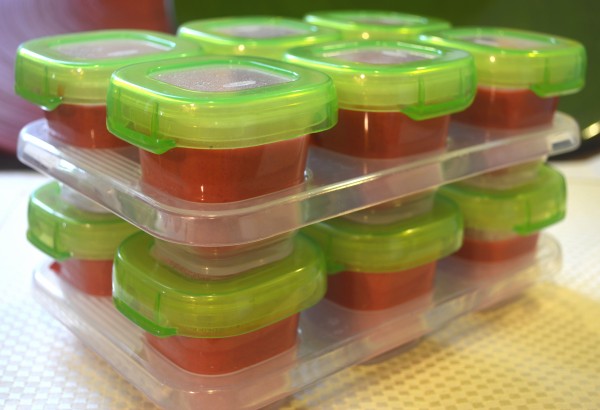
- When making the bottle, mix 2 ounces baby food with 7 ounces formula or breast milk. Immediately before feeding, shake well to distribute the food throughout the liquid. Typically, after the baby has drank 6 or 7 ounces, enough of the food has settled into the remaining 2 ounces that we can add another 6 or 7 ounces of formula or milk while still retaining the flavor and nourishment of the original mixture. After the baby drinks this second filling, we're ready to switch to a new bottle with the next container of food. This provides 15 ounces of "PHD Baby Milk" twice a day, a good quantity for most infants, especially combined with solid food.
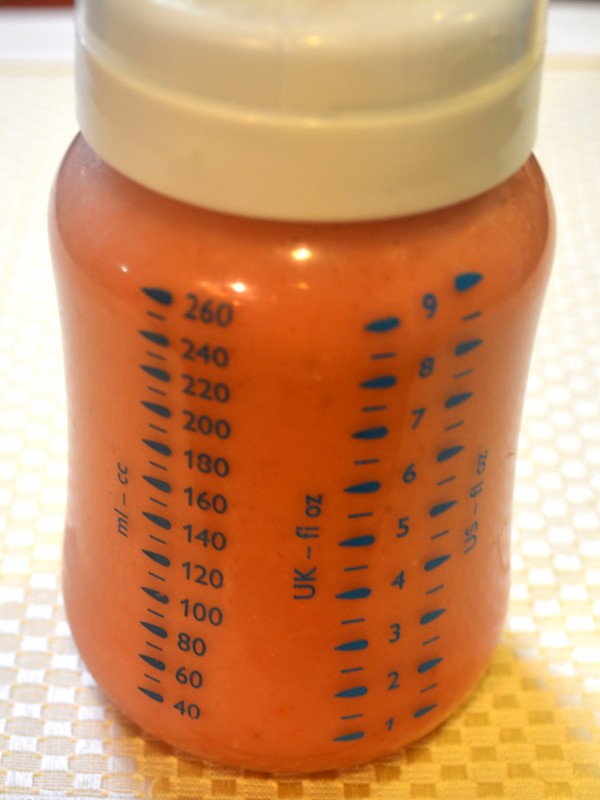












What a boy!
Interesting post – do you eliminate egg whites completely ?
yes
Do you eliminate egg whites for all ages, as well? We delayed egg whites for at least one year for our two. When would you start letting children eat egg whites?
Yes. We would let Luke eat a cooked egg white at any age, but wouldn’t provide it ourselves. So it would be a rare occurrence.
Maybe I missed something, but why no egg white? I understand why no raw whites, but I thought cooked was a PHD-approved protein source. My daughter is 2, so I’m especially curious about toddler egg consumption.
I’m really enjoying your info about baby food, by the way.
Hi Bella,
Egg whites are permitted but not recommended. They’re mostly protein, protein is a limiting/satiating factor in food intake, and generally meat and fish are more nutrient dense and better ways to get protein-associated nutrition. There is also a sensitivity/allergy risk from eating whites.
What a gorgeous little guy!
Paul, can you please share what brand of formula you used for Luke? I had to supplement my little one too and agonized over what brand of formula to use.
We’ve used mainly Similac Advance with lesser amounts of Enfamil Newborn and Gerber Gentle Good Start.
Thank you,Paul!
Good thing you two are in such good shape or that kid would wear you out soon! Adorable!
Why blend it at all?
We just put the food in front of our kids on their high chair tray and let them figure it out. Doesn’t work very well with liquids but for everything else it’s great. Sure it’s a little messy (we have dogs though) but both of our kids ate pretty much everything we gave them. We don’t have to feed it to them, in fact with our second it’s almost impossible to put anything in his mouth, he has to do it himself. There’s always a risk of choking either way but the only thing we’ve seen them struggle with in that respect are long noodles. I think that when they put things in their mouth themselves it makes them more aware of where it is. If you see people spoon feeding their babies, it’s going quite a way back into their mouths which might surprise them. I think the technique is called baby led weaning. I don’t necessarily agree with their food choices but our kids are such good eaters I can’t argue with the self feeding part.
Letting baby self-select foods is a great tactic and I would favor that as a next step in transitioning toward pure solid food diets and joining in family meals.
One problem is that we often make a single complete meal that is pre-mixed, such as a stew or soup, and the baby can make a mess with it. I think there’s a place for parental feeding.
Hello ! Is it safe to jump from milk only to this Recipe? Or I need to introduce the ingredients little by little?
Thank you !
Thank you for sharing the photos and videos- Luke is so cute! I have a million questions about feeding infants and toddlers but I’ll restrain myself! 😀
One quick question though- how is the taste of the puree before mixing with milk or formula? Does it have a strong liver flavor? I’m asking because I’ve struggled to prepare liver except a few times where I blended it into meatloaf (my daughter is now 19 months so she’s eating pretty much whatever we eat). I was thinking this preparation looks easy and quick enough that it might help me serve liver more often. I worry if she’s getting enough vitamin A and copper or not so liver has been on my mind for weeks. She does love creamy chicken liver pate which I’ve made only twice but I know that doesn’t have much copper.
Also, do you favor any particular brand of coconut milk? I ordered a case of Natural Value brand after reading so many great reviews on websites I visit but have not used it because the product looks very gray and almost curdled looking. I was worried if can lining is leaching into coconut milk. Anyway, do you think the ones with guar gum or xantham gum are ok?
Hi KH,
The taste should be delicious – a cross between a PHD adult meal and a dessert. You can adjust ingredients to make it more delicious. You don’t want the liver to be dominant, the quantity needs to be small.
It’s not a bad thing to substitute chicken liver for beef liver, at least some of the time.
We have some favorite coconut milks but usually buy from Asian groceries. Expensive is not better, as a rule. I am positively disposed toward ones that use sodium metabisulfite as preservative.
Best, Paul
Thank you Paul! I made it yesterday and it was a success! Next time I might add more sweet potato or various types of sweet potato. My mixture, after pureeing with immersion blender, was sticking to pot a little so I added extra water and some coconut oil. After it all cooled, I put into baby jars and froze. I gave my daughter a couple tablespoons of the puree by itself and she ate it as is! Yay! Later that afternoon however she was less thrilled with it so I mixed it with some thin coconut milk (I made some from dried unsweetened coconut flakes to use in recipe). She happily drank that. This got me thinking about how much fat she consumes… Is it worrisome if she consumes a pretty good amount of fat? For example, mixing the puree with coconut milk and whenever we give her rice (usually white basmati, sometimes Japanese sticky rice), she only likes it well-coated in butter and salt. We usually add a little rice vinegar too. Same preparation with potato and sweet potato. I usually set out a few different things in front of her to eat (some carbs with fat, a protein, some cooked or occasionally raw veggies, fruit) so I like to think she will eat what her body needs and I don’t need to worry too much. But does it sound like too much fat? (She will usually eat rice with at least two meals a day.) she also seems to eat lots of protein. I have nothing to compare to so I don’t know if she’s actually eating SO Much protein, she just seems to eat well. Again she’s 19 months so maybe more protein is expected since she’s a little bit older? Also she likes salt. She asks for it a lot when she’s eating. I don’t know if it’s the grinding salt shaker apparatus that fascinates her or if she just likes salt or if there’s a problem…? I do salt her food so I’m fairly positive she’s not lacking it. Sorry, I know you probably can’t address all this, but any quick comments?
Also, I blended some of the puree together with frozen blueberries and peaches and poured into Popsicle molds. Probably defeating the purpose of getting used to the PHD flavors!! But I already know she likes most of PHD food so I was just trying to get her to eat some of the liver easily. She ate a Popsicle on a walk this morning! Another yay! Thank you so much for sharing your recipe! It’s been a huge inspiration to me!
Hi KH,
Great! I’m glad she likes it. Yes, the older she gets, the more protein she can have. Still it will be less than an adult would want. I don’t think the extra fat is a problem, you can trust her taste preferences. Same with salt. Just make sure she gets fruit and vegetables to balance it.
Interesting about the salt shaker, Luke likes to play with a pepper shaker. He uses it is a teether, not eating pepper directly, but there is a pepper flavor and smell to the plastic.
Popsicles is a great idea! It will still taste like PHD food.
Best, Paul
Shou-Ching adds that while simmering the mixture should be covered to prevent loss of water, and the heat as low as possible. I’ve updated the recipe to reflect that.
Ah, I didn’t cover it til the end. That makes sense. Thank you both so much!
Looking forward to any other baby food recipes or posts!
I’m curious, how would you adjust the recipe for adults? (And would you mix it with cow milk?) Supposing, for the sake of argument, that someone wanted to try it as a meal replacement.
The recipe for adults is the PHD food plate.
That’s not what he asked.
But he answered it.
Hi Paul,
Are there any foods you would stop Luke from eating, perhaps at a Children’s Party, such as gluten containing foods or items in the don’t eat section of the PHD?
Thanks,
Claire
Hi Claire,
Not really. A little bit of gluten or peanuts may promote immune tolerance and enable him to eat it more safely later. Probably super-sugary things like candy or soda we would try to stop him from eating, but we would take it in stride if he did.
Another Claire writing:
Thanks for clarifying this issue. I sometimes get concerned about grandparents/parties giving gluten foods. Most parties we’ve been to only have gluten foods (i.e. hardly anything without gluten). So you think even a whole gluten pizza would be OK for a child once in a while? My husband feels they should not be ‘deprived’ from eating it. I myself am gluten sensitive however.
Hi Claire,
I focus on giving him good things in our home and don’t worry too much about what goes on outside. In the end, he’s going to know what’s available outside and will have to choose to eat PHD himself. Going to extraordinary lengths to avoid forbidden foods risks glamorizing those foods. But, if we thought he might be gluten sensitive, my view would be different.
I’m not too sure about this. Once they get a bit older they’re swarmed with junk food. Between school, family and parties our kids would be ingesting sugary gluten containing foods 2-3 times a week. They’d choose the cupcakes and cookies every time if we let them. Sometimes a little parental guidance is necessary outside of the home. Just my two cents.
This looks great. I wish I had found this a few months ago! Still useful with a one-year old, though.
Max’s favorite food is chicken liver pate made with ghee, so I think he’s going to like this. Good stuff!
My uncle was the vice president of Ross Labs, which is the company that invented Similac and Ensure. He’s retired now. Can I ask why you didn’t use the famous Weston A. Price formula? Just curious, I don’t have an opinion about it.
It is too high in protein and some other things, low in some nutrients. It is hard to replicate breast milk through food.
I thought the main objection to commercial baby formulas was the soy content. Is that not such a problem?
Do you have a PHD recipe for an alternative to Ensure?
Super cute pictures! How fun!
We will by trying the recipe, thanks very much! One questions, why no added magnesium (or other minerals)?
Thank you, thank you, thank you for sharing the photo of Luke “running” home from church. You have transported us back to that feeling of sheer exhilaration and joy a toddler feels when he discovers what his legs can do! Our son, Dan (now 36!) did the exact same thing when he was exactly Luke’s age. He was an early walker also and one night we were at the New Jersey shore and decided to take Dan for a walk on the Atlantic City boardwalk in his umbrella stroller. He emphatically wanted out of the stroller as soon as we got there and wanted to push it, which he wound up doing for nearly a mile, his little legs going, going, going. He was wearing powder blue knitted booties on his feet which were BLACK on the bottom after this journey! Oh, how these children inspire us and remind us daily of the joy of simply being alive and moving!
Hi Paul,
I was just wondering if you had any concerns about malocclusion arising from the pacifier. I think I read that there is a connection on Stefan’s blog
Henry
No, not from use at age one. From use at age 4, yes.
I can’t wait to try this recipe for my baby in a month or two. What is the nutritional benefit of the fish sauce?
Primarily, it is a source of nucleotides, which support growth (via DNA and RNA formation). It also has some vitamins like B12, K2.
Thanks, that’s interesting
Please research thoroughly what microwaving does to the structure of food. I don’t agree with that part of the directions. The rest sounds very nourishing.
Your measurements are in grams – 100 grams is about 3.5 ounces – are these fluid oz to be measured in measuring cup or ounces by weight on a little food scale? Also hand immersion blenders have a huge magnetic field and one has to hold them awhile manually. Would a blender work too or would food processor be better? Have you ever tried those? Thanks for the great recipe – I am passing this on to my niece.
Donna, I’m concerned about magnetic fields and find this comment interesting, especially as I was making fresh soup every evening this past summer with an immersion blender. I do have a food mill now and could use it, though it creates much more to wash. Could you send some sources/information please?
Paul have you considered using a pressure cooker for this recipe?
I admire your faith and dedication, Paul.
Thank you Razwell.
Luke is such a cutie. He reminds me of my three grandkids. 😀 My oldest grandson is six, and his first and longtime favorite food was liver pureed with banana. He still loves bananas, but liver not so much, LOL. He loves his rice though and claims that is due to his half Chinese heritage, but his little sister is not a rice fan and much prefers her potatoes. We say she is expressing the Irish side of her heritage! The baby is six months old and my DiL is starting to contemplate what sort of foods she should introduce, so far it’s just been some tastes of yogurt or sour cream.
All three kids are slender (well the baby has the appropriate amount of chub but not too much) but in the 99th percentile for height, so my son and DiL must be doing something right, though their typical diet is far more carb-centric than PHD tends to be.
Dear Dr. Jaminet,
My wife and I are parents to a 7 month old son and we have just barely scratched the surface of feeding him solids. He tolerates small amounts of sweet potatoes, but banana and avacado has made him sick (throwing up). He is primarily breast fed, but we are a little confused on where to go from here with solids. The amount of my wife’s milk during the day is decreasing and we probably need to supplement with some solids.
We do not necessarily want to follow the standard protocol of cereals at 6 months, then veggies, then fruits, and finally meats down the road. However, we are concerned about introducing meats at such a young age. Should we be concerned about introducing meat at this age? (By introducing meat, I am referring to mixing a small amount of beef liver with sweet potatoes and breast milk).
Thank you for your input,
Chris
My six year old saw me reading this posts and thinks it looks very yummy! Side note: I fed her liver often as a baby… I think it’s time for me to start giving her liver again!
Update: she asked if I could make this for her this week, so we’re having this for dinner very soon! Thank you for sharing this recipe.
Hi Paul,
You do not include any stock in it?
Thanks
Why not introduce the baby to different tastes and textures in stead of giving him liquid food all the time? The whole point of weaning is trabsutioning the baby to table foods. What purpose is being served if your child is having suoersmooth mixtures from botyles, mixed with milk all the time? When will he learn to eat the real food and understand how to chew?
We have been transitioning him to table foods since age 6 months. This is a way of getting the flavor of our table foods into milk. It is a transition tool.
This may have been covered somewhere else on the site but I have yet to discover where.
I have three children between the ages of 8-10 who eat the PHD way. Is vitamin/mineral supplementation recommended for children? If so, what are your recommendations? If not, why?
Hi Mage,
Generally, children need fewer supplements. There are a few exceptions, for example vitamin K2 is more needed by growing children than adults. However, even that can be provided by fermented foods such as cheese and green leafy vegetables. So a lot depends on the quality of the children’s diet, and selection of supplements to make up for what is missing.
Best, Paul
Thanks, we are looking forward to following all this great advice for our newborn. My wife is pregnant in her first trimester. Would this be safe for her to eat, or is there a danger with shellfish? Also, should she avoid vitamin K supplements?
Hi Mike,
Yes, it’s safe for your wife. Shellfish are good for her as long as she doesn’t have an allergy. She should take vitamin K supplements, or eat lots of green leafy vegetables and fermented foods. She should take iodine 225 mcg/day as well.
Best, Paul
Thanks, I see many sites warning about too much Vitamin A during pregnancy. e.g.
“Preformed vitamin A is found in animal products like eggs, milk, and liver. Too much of this type of vitamin A in your diet can cause birth defects in your developing baby, especially during the first months of pregnancy.”
Is this a real concern?
I want to try this baby food for my 19 month old. However, he is on a very restricted diet. He had 6 different antibiotics before his first birthday leaving his gut a mess. We are in the process of healing his gut right now. With this he cannot have fructose, coconuts or other nuts, or dairy. With eliminating the beets and carrots should I adjust to increase the rice and white potatoes or leave as is? Also can I use water instead of coconut milk or use more breast milk?
Thank you for your help.
Best,
Claire
Hi Claire,
Why not try it as is and see if he tolerates it? Beets and carrots don’t have amounts of fructose that should cause problems, and coconut milk is unlikely to be a problem either.
Best, Paul
Oh My word, your baby is beyond cute. He looks so robust and muscular. Congratulations. Very gorgeous little man.
What do you think about using a portion of bone broth (basic recipe: bones/joints and water) to replace some of the water?
Hi Paul,
How is Luke doing? My little girl is about 6 or 7 months older than Luke, if I remember correctly from your post after Luke was born. I was hoping you might have some insight or recommendations about nutrients for toddlers. She turned 3 at the end of January. She eats pretty good I think but for the past 6 months she’s become a little picky. I shop around for vitamins for her, thinking maybe I need to fill in any gaps of nutrients she might not be getting. I’ve noticed that most, if not all, toddler/ children vitamins don’t have any copper and often no selenium, but they seem to all have both iodine and zinc. I can’t get her to eat liver unless it’s a tiny tiny ratio mixed into meatloaf. I know she wouldn’t need much but anyway I’m worried if she’s not getting enough copper. She will occasionally eat almond butter and some nuts though. I was also concerned if she gets enough selenium. She does eat protein easily- chicken thighs or roast chicken with the skin, she loves salmon and eats ground beef/ hamburger every week. So far she hasn’t liked any other seafood though. She hasn’t liked egg yolks very often recently though (we usually fry them over easy and she just scoops out yolk to eat. She eats veggies like carrots with almond butter and sometimes kale chips or sautéed spinach. She likes avocados usually. Her diet is probably well rounded but she doesn’t eat all these regularly- some days she refuses lots of these then next day she will eat them.
Do you have any thoughts about picky toddlers? Does Luke still eat liver? Any tips?
I haven’t been giving her any dairy for a few months (except butter) because she gets red bumps around her mouth when she has anything like cheese or yogurt. Also I’m concerned about vitamin A since she doesn’t eat liver and I do give her vitamin D drops.
Thank you so much for any thoughts you might have!
KH
Hi KH,
Luke is doing very well, thank you.
Children generally don’t need many supplements. Vitamin K2 (if they don’t eat a lot of fermented foods), zinc, vitamin D in winter are most important. Egg yolks are important, an iodine source such as seaweed, and a vitamin A source such as liver.
Children need a much higher ratio of zinc to copper than adults, so generally if you feed them some nuts and chocolate they don’t have further need for copper. This means you can give them chicken liver for A and choline rather than beef or lamb liver, which may aid in palatability. If you must supplement, get a vitamin A capsule, cut the top off with a pair of scissors, and squeeze the oily insides into a glass of milk.
I wouldn’t worry about selenium. Also I wouldn’t worry about variations in what she eats, children tend to self-select wisely so if she skips a food one day it may just mean she didn’t need it.
For Luke, we just make sure healthy foods are around and let him eat what he wants. As long as there’s no junk food and the choices are natural whole foods, he will do OK.
Best, Paul
Thank you Paul, very much appreciated! And Happy Mother’s Day Shou-Ching!
Happy Mother’s Day KH!
So I’d like to start this for DD (8 months) but so far she has a cashew & egg (both yolks & whites) allergy. I noticed in the comment above you mentioned not worrying about copper if feeding nuts.
How would you adapt this item?
Paul, any advice on the dietary needs for women that are breastfeeding? My girl friend has been breastfeeding for 3 months now. At a recent dentist appointment, the doc found 5 cavities. She is not typically prone to cavities. And her baby has bouts with eczema at times. So they are obviously deficient in some nutrients. Thanks in advance for your advice.
P.S. Awesome to read your updates on baby Luke’s progress! Great looking kid 🙂
Hi NewYorker,
She should be eating 5-7 egg yolks per day, plus liver weekly, many carotenoid rich plants (e.g. carrots, green leafy vegetables), supplementing vitamins E and C and K2, supplementing calcium and magnesium and iodine, and potentially/probably some glycine, taurine, and N-acetylcysteine. As well as eating PHD.
Best, Paul
Hi Paul. Do you think it would be beneficial to “fortify” a commercial baby formula for a formula-fed baby under 6 months? For example, the Weston A Price formula fortification recipe which calls for 1 yolk and 1/2 teaspoon cod liver oil per litre of formula. Thank you.
Hi Paul,
Thank you for this detailed post. I hope Luke is doing well! I have been breastfeeding my daughter for almost a year now, and I am thinking of weaning her from breastmilk. She’s been having solids since 6 months as well, generally following the PHD.
What milk did you give Luke when you transitioned? Did you use goat milk or cow milk? Or is there alternative to those two that you preferred for Luke?
Thanks, Amy
Hi Amy,
We used both formula and cow’s milk.
Best, Paul
Hi Paul. I went to the fish market yesterday to get what I needed to make this recipe. When I asked for 5 grams of each item listed, he looked at me like I was nuts! 5 grams is so small it’s almost immeasurable. For example, one oyster alone was 50 grams. So I ended up getting 50 grams each of salmon, scallops, and oyster, and I have liver here at home. Can you please suggest how I should proceed? How do you purchase and measure 5 grams of these ingredients??
Hi Katie,
The general assumption is that you are cooking for a family, mom and dad will eat liver once a week per PHD, oysters once a week, salmon once a week, etc., and that you can set aside a bit for the baby food which you may make once a week. 5 g is one teaspoon. So, when you make salmon, set aside one teaspoon for the baby food, and grind it up with other ingredients.
Best, Paul
Hi Paul, my husband and I are admirers of your work and have followed the PHD diet for sometime now, albeit not perfectly, but we do our best. Thank you for the great info. We now have a hungry 5 month old baby, who is exclusively breastfed, but seems to be wanting a little more food maybe … he isa good weight, but I am finding it very hard to keep up with his demands, and he is still feeding a lot in the night – think some of this might be for comfort though. Please can you share how you introduced formula into your son’s diet, at which age and also you thoughts on the high end goats milk formulas vs the standard cow’s milk ones … have heard some babies do better on goat’s. We are also going to try your PHD baby food, but we can’t until around 6 months and one week as the first week over 6 months he is with us on a family vacation overseas. Any advice greatly received.
Hi Paul,
Thank you so much for this recipe it’s exactly what I’ve been looking for! feeding apple purees to babies just wasn’t making sense to me! We have a 4 month old so are just starting to consider solids and weening.
Could you add any comment about what next, and specifically in relation to sea salt and babies and also anything they shouldn’t have before a certain age… Also how do you deal with well meaning family members who want to give white bread and sweets etc because they don’t follow the same way of eating… Many thanks Alex and Owain 🙂
Thanks Paul for this great overview and recipe – hope Luke is continuing to do well!
A logistical question: we’re finding that even after using a sieve to filter out pieces of the solids used in the recipe, tiny bits of food matter are getting stuck in the holes of the bottles we use, making it tough for our son to draw PHD milk out of the bottles. He’s 11 months, so still a bit too young to aptly use a sippy cup. Did you encounter this problem? If so, is there any solution that worked for you?
Hi Jordan,
Two possibilities. One is that you will need to use a nipple with a larger opening. Nipples are sized by age and the nipples for older kids have larger openings that are less likely to get clogged. Here’s an example: https://www.amazon.com/NUK-Silicone-Orthodontic-Nipples-Months/dp/B00GYXKGRO/
The other is that you need to cook the vegetables longer and grind them more finely with the blender. Try simmering them for 30 minutes. You can also pre-cook vegetables in a pressure cooker / Instant Pot if you have one.
Best, Paul
This may be a silly question but does anyone know the weights in the recipe are cooked or uncooked (except the rice of course which is stated). Many thanks!